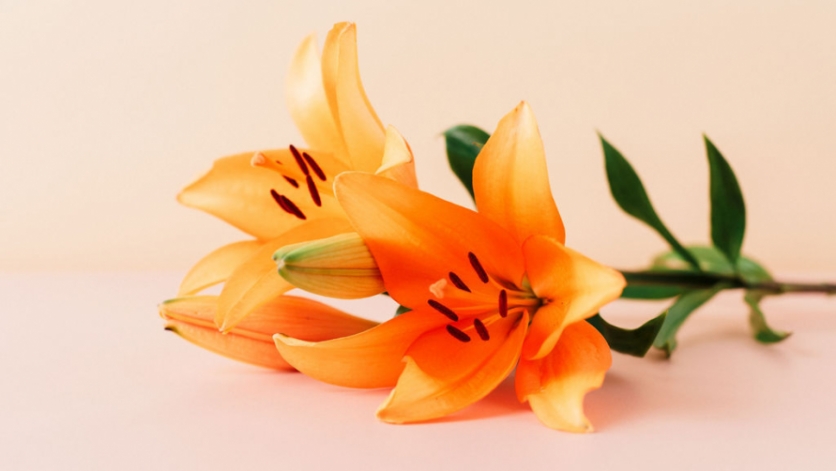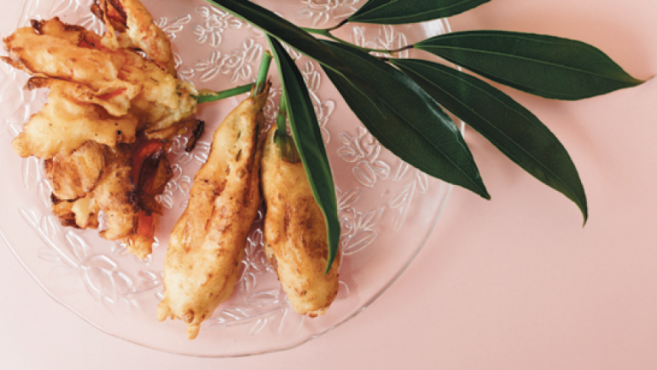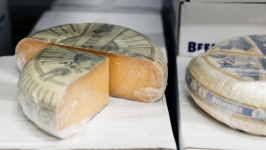Bountiful Blooms: The Fleeting and Flavorful Daylily

Eating flowers feels like decadence.
For all of their vibrant showiness, flowers are often the forgotten plant part in home cooking. Roots, leaves, stems and fruit show up in their many forms and flavors in our kitchens, but dishes featuring edible flowers tend to be relegated to fine dining. Even then, flowers are frequently peripheral—colorful accents decorating the edges of our plates, there to bring a bit of beauty but little real substance to a meal.
In some ways it makes sense that most standard recipes don’t use blooms as headlining ingredients. The few vegetables we use in bud form, such as broccoli and artichoke, are hearty and tough before they open fully. Delicate flower petals, on the other hand, are far more perishable. Their tendency to wilt and bruise makes transport and storage a challenge. But while edible flowers are a tough sell in supermarkets, they are the perfect seasonal find nestled among just-picked produce at a farm stand or when harvesting our own food.
Fresh flowers can cover a wide range of flavors and uses in our culinary repertoires, and since many of them appear in large quantities at various points in the season, they can make a true dent in our produce needs with little to no cost. Nasturtium, chicory, dandelion, calendula, yellow goat’s beard, marigold, borage, black locust, milkweed—the list of wild and cultivated flowers that I use in my own cooking goes on and on. Some edible flowers are so common in North America that we overlook them as a part of the landscape or title them “weeds” (a phenomenon I’ve written about in this series before), but many of these same blooms are standard ingredients elsewhere in the world.
Daylilies are the perfect example of a plant so ubiquitous in many areas of the United States that we barely notice them anymore. And while the concept of the daylily as an edible crop has been largely forgotten in our neck of the woods, daylily tubers were brought over from Asia where the flowers have been featured in recipes for centuries.
The common daylily was planted as an ornamental in the United States in the 1700s. The plant proved so successful at spreading that many field guides now consider it to be wild and, in some regions, invasive. Not to be confused with the unrelated tiger lily or other varieties of “true lily,” perennial daylilies’ tall, thin stalks and large blooms appear in swaths along roadsides, in fi elds and backyard corners, covering old homesteads and fl owering along wooded paths. Daylily and tiger lily are easiest to distinguish by their leaves. A daylily’s grass-like leaves grow slender and tall directly from the soil, while a tiger lily’s much shorter leaves appear in spirals (or whorls) all along a single thick stem that attaches to a central bulb.
Daylily shoots are one of the first green things to poke their heads above ground after a long winter of snowfall and freezing temperatures, their new leaves pushing through the newly warmed soil alongside tulip, iris and spring beauty. While the tubers and shoots can be harvested and eaten as well, I generally leave these be, instead waiting for the bountiful buds and characteristic orange and yellow flowers that arrive with the longer spring days.
Daylily flowers open only for a single day, giving them their name, and can be harvested for use when the buds are still small, in large bud form, when the flowers are fully opened, and even once the flowers have closed again. As an ingredient, daylily flower buds and blooms are fragrant, mild and fresh tasting. Of all the foraged items I serve to guests in my home, daylily is one of the biggest crowd-pleasers. With none of the bitterness of some wild foods yet with their lovely fl oral scent, these versatile flowers have brought around some of the most unadventurous eaters I know.
I throw daylily petals into salads and pasta dishes, particularly during the last few moments of simmering a cream sauce. I chop and sauté buds with garlic as a side dish, and add them into frittatas, omelets, rice dishes and soups. Much like the squash blossom, fully opened daylily flowers are wonderful stuffed with ricotta or rice and batter-fried to a golden crisp. Still tightly closed daylily buds make a gloriously pumpkin-hued fridge pickle, and the smaller buds chopped fine are a great addition to homemade relish. My favorite way to cook both daylily buds and flowers (to the surprise of no one in my life) is to fritter them. As I’ve stated here before, I’ve rarely met a garden vegetable that isn’t incredible frittered, especially when served alongside an aioli dipping sauce.
And as those fine-dining restaurants know, flowers can transform a simple dish into something beautiful. That surprising bit of color and decoration can change a meal from something necessary into something to be savored. So while you’re chopping and preparing your daylilies for cooking, save one for a garnish. Because not all decadence needs to come at a high price, and sometimes beautiful things can also be delicious.
*Note: As with all foraging, you should refer to fi eld guides and experts for 100% positive identifi cation before consumption. New wild foods should be always introduced into your diet in small quantities to gauge any dietary sensitivities. Additionally, consult with a doctor if you have any questions or concerns about specifi c health issues, medication interactions, allergies, pregnancy or breastfeeding.






